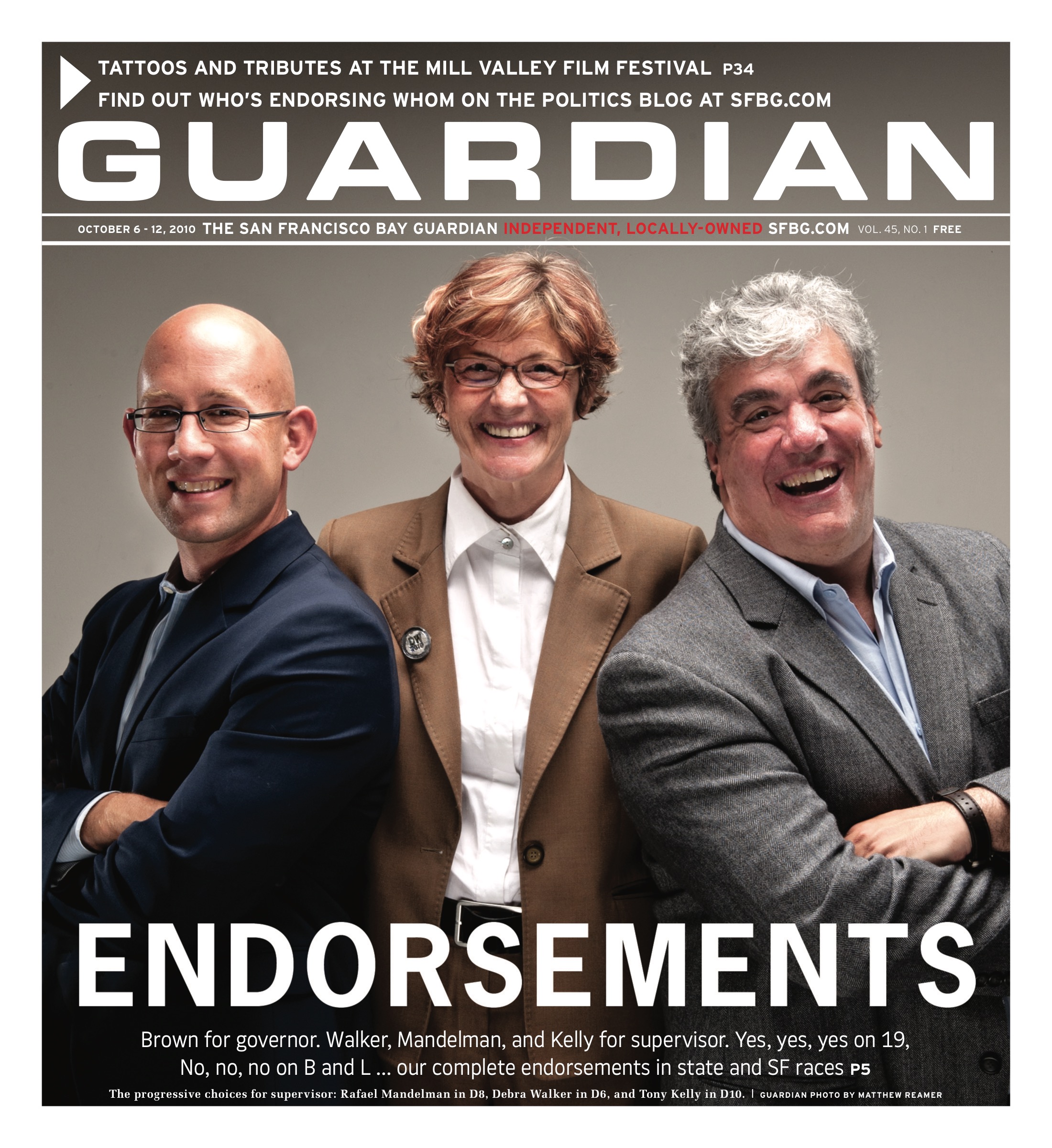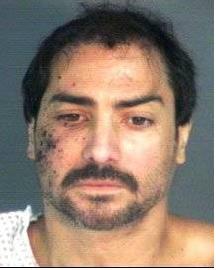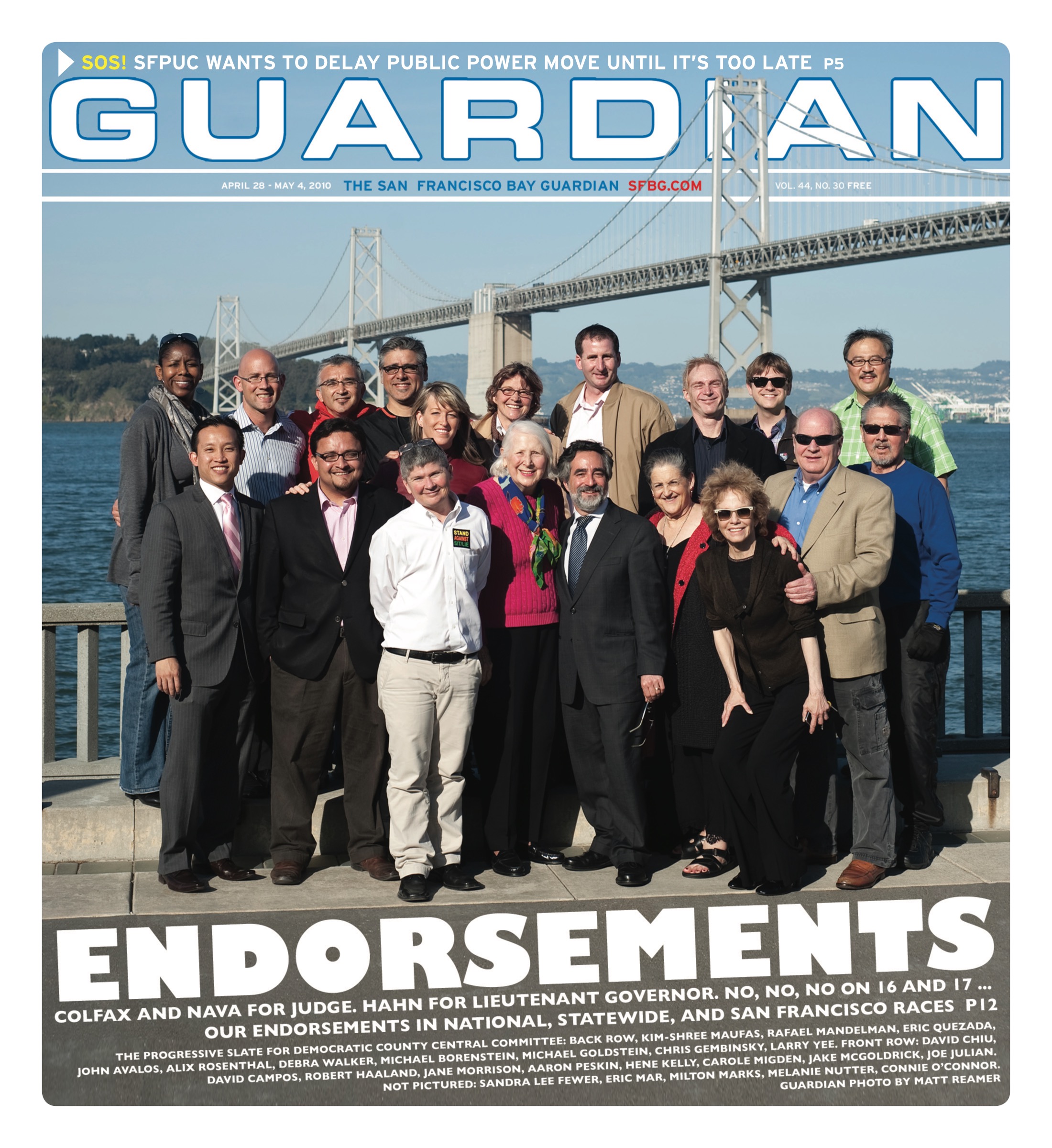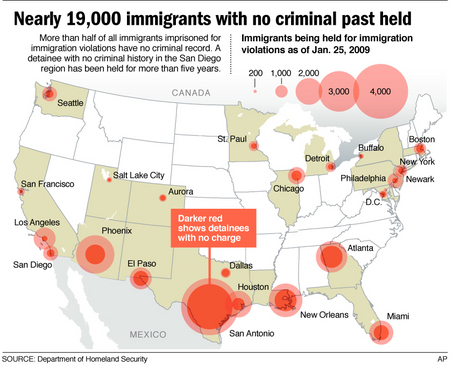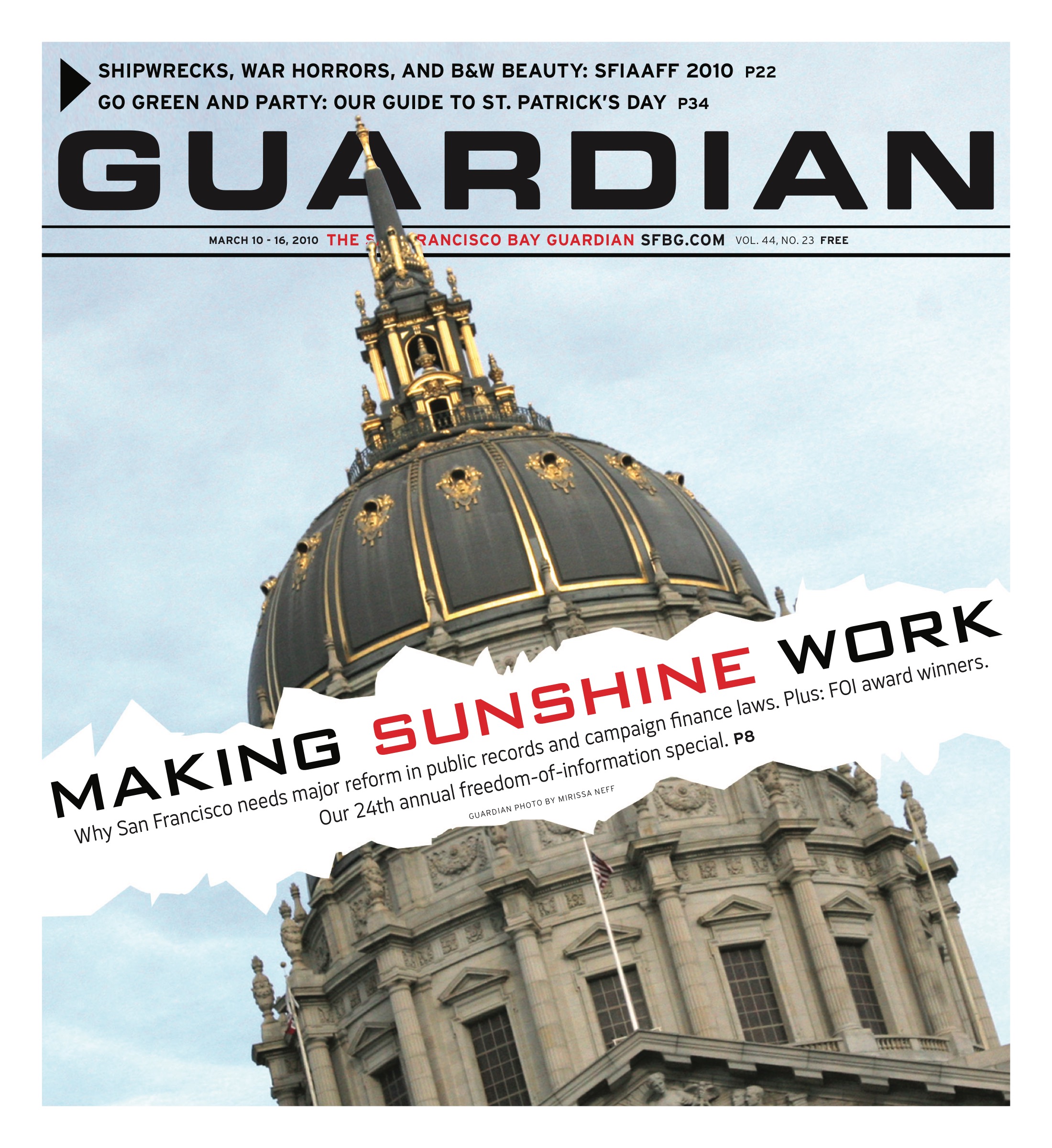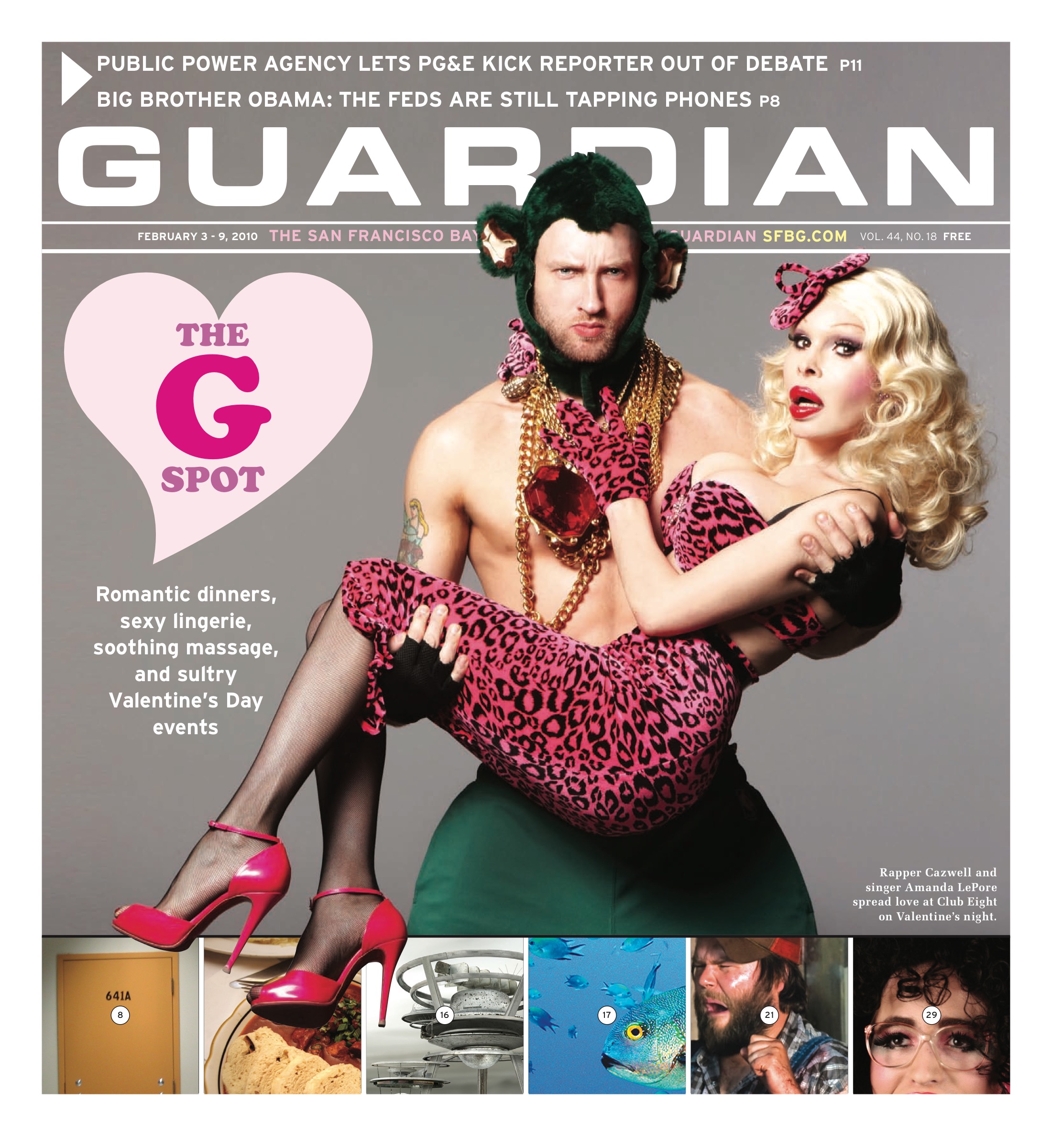› amanda@sfbg.com
The daily dispatches and nightly newscasts of the mainstream media regularly cover terrorism, but rarely discuss how the fear of attacks is used to manipulate the public and set policy. That’s the common thread of many unreported stories last year, according to an analysis by Project Censored.
Since 1976, Sonoma State University has released an annual survey of the top 25 stories the mainstream media failed to report or reported poorly. Culled from worldwide alternative news sources, vetted by students and faculty, and ranked by judges, the stories were not necessarily overtly censored. But their controversial subjects, challenges to the status quo, or general under-the-radar subject matter might have kept them from the front pages. Project Censored recounts them, accompanied by media analysis, in a book of the same name published annually by Seven Stories Press.
"This year, war and civil liberties stood out," Peter Phillips, project director since 1996, said of the top stories. "They’re closely related and part of the War on Terror that has been the dominant theme of Project Censored for seven years, since 9/11."
Whether it’s preventing what one piece of legislation calls "homegrown terrorism" by federally funding the study of radicalism, using vague concerns about security to quietly expand NAFTA, or refusing to count the number of Iraqi civilians killed in the war, the threat of terrorism is being used to silence people and expand power.
"The war on terror is a sort of mind terror," said Nancy Snow, one of the project’s 24 judges and an associate professor of public diplomacy at the Newhouse School of Public Communications at Syracuse University. Snow — who has taught classes on war, media, and propaganda — elaborated: "You can’t declare war on terror. It’s a tactic used by groups to gain publicity and it will remain with us. But it’s unlikely that [the number of terrorist acts] will spike. It spikes in the minds of people."
She pointed out that the number of terrorist attacks has dropped worldwide since 2003. Some use the absence of fresh attacks as evidence that the so-called war on terror is working. But a RAND Corporation study for the Department of Defense released in August said the war on terror hasn’t effectively undermined Al Qaeda. It suggested the phrase be replaced with the less loaded term "counterterrorism."
Both Phillips and Snow agree that comprehensive, contextual reporting is missing from most of the coverage. "That’s one of my criticisms of the media," Snow said. "They spotlight issues and don’t look at the entire landscape."
This year the landscape of Project Censored itself is expanding. After talking with educators who bemoan the ongoing decline of news quality and want to help, Phillips launched the Truth Emergency Project, in which Sonoma State partners with 23 other universities. All will host classes for students to search out untold stories, vet them for accuracy, and submit them for consideration to Project Censored.
"There’s a renaissance of independent media," Phillips said. He thinks bloggers and citizen journalists are filling crucial roles left vacant by staff cutbacks throughout the mainstream media. And, he said, it’s time for universities, educators, and media experts to step in and help. "It’s not just reforming the media, but supporting them in as many ways as they need, like validating stories by fact-checking."
The Truth Emergency Project will also host a news service that aggregates the top 12 independent media sources and posts them on one page. "So you can get an RSS feed from all the major independent news sources we trust," he said. Discerning newshounds can find reporting from the BBC, Democracy Now!, and Inter Press Service (IPS) in one spot. "The whole criteria," he said, "is no corporate media."
Carl Jensen, who started Project Censored in 1976, said the expansion is a new and necessary phase. "It answers the question I was always challenged with: how do you know this is the truth? Having 24 campuses reviewing all the stories and raising questions really provides a good answer. These stories will be vetted more than Sarah Palin."
Phillips said he hopes to expand to 100 schools within the year, and would like the project to bring more attention to the dire need for public support for high quality news reporting. "I think it’s going to require government subsidies and nonprofit organizations doing community media projects," he said. "It’s more than just reforming at the FCC level. It’s building independent media from the ground up."
Phillips likens it to the boom in microbrewed beer and the spread of independently-owned pubs: "If we can have a renaissance in beer-making, following established purity standards, then we can do it with our media, too." But for now, we have Project Censored, whose top 10 underreported stories for 2008 are:
1. HOW MANY IRAQIS HAVE DIED?
Nobody knows exactly how many lives the Iraq War has claimed. But even more astounding is that so few journalists have mentioned the issue or cited the top estimate: 1.2 million.
During August and September 2007, Opinion Research Business, a British polling group, surveyed 2,414 adults in 15 of 18 Iraqi provinces and found that more than 20 percent had experienced at least one war-related death since March 2003. Using common statistical study methods, it determined that as many as 1.2 million people had been killed since the war began.
The US military, claiming it keeps no count, still employs civilian death data as a marker of progress. For example, in a Sept. 10, 2007, report to Congress, Gen. David Petraeus said, "Civilian deaths of all categories, less natural causes, have also declined considerably, by over 45 percent Iraq-wide since the height of the sectarian violence in December."
But whose number was he using? Estimates range wildly and are based on a variety of sources, including hospital, morgue, and media reports, as well as in-person surveys.
In October 2006, the British medical journal Lancet published a Johns Hopkins University study vetted by four independent sources that counted 655,000 dead, based on interviews with 1,849 households. It updated a similar study from 2004 that counted 100,000 dead. The Associated Press called it "controversial."
The AP began its own count in 2005 and by 2006 said that at least 37,547 Iraqis had lost their lives due to war-related violence, but called it a minimum estimate at best and didn’t include insurgent deaths.
Iraq Body Count, a group of US and UK citizens who aggregate numbers from media reports on civilian deaths, puts the figure between 87,000 and 95,000. In January 2008, the World Health Organization and the Iraqi government did door-to-door surveys of nearly 10,000 households and put the number of dead at 151,000.
The 1.2 million figure is out there, too, which is higher than the Rwandan genocide death toll and closing in on the 1.7 million who perished in Cambodia’s killing fields. It raises questions about the real number of deaths from US aerial bombings and house raids, and challenges the common assumption that this is a war in which Iraqis are killing Iraqis.
Justifying the higher number, Michael Schwartz, writing on the blog AfterDowningStreet.org, pointed to a fact reported by the Brookings Institute that US troops have, over the past four years, conducted about 100 house raids a day — a number that has recently increased with assistance from Iraqi soldiers.
Brutality during these house searches has been documented by returning soldiers, Iraqi civilians, and independent journalists (See #9 below). Schwartz suggests the aggressive "element of surprise" tactics employed by soldiers is likely resulting in several thousands of deaths a day that either go unreported or are categorized as insurgent casualties.
The spin is having its intended effect: a February 2007 AP poll showed Americans gave a median estimate of 9,890 Iraqi deaths as a result of the war, a number far below that cited in any credible study.
Sources: "Is the United States killing 10,000 Iraqis every month? Or is it more?" Michael Schwartz, After Downing Street.org, July 6, 2007; "Iraq death toll rivals Rwanda Genocide, Cambodian killing fields," Joshua Holland, AlterNet, Sept. 17, 2007; "Iraq conflict has killed a million: survey," Luke Baker, Reuters, Jan. 30, 2008; "Iraq: Not our country to return to," Maki al-Nazzal and Dahr Jamail, Inter Press Service, March 3, 2008.
2. NAFTA ON STEROIDS
Coupling the perennial issue of security with Wall Street’s measures of prosperity, the leaders of the three North American nations convened the Security and Prosperity Partnership. The White House–led initiative — launched at a March 23, 2005, meeting of President Bush, Mexico’s then-president Vicente Fox, and Canadian Prime Minister Paul Martin — joins beefed-up commerce with coordinated military operations to promote what it calls "borderless unity."
Critics call it "NAFTA on steroids." However, unlike NAFTA, the SPP was formed in secret, without public input.
"The SPP is not a law, or a treaty, or even a signed agreement," Laura Carlsen wrote in a report for the Center for International Policy. "All these would require public debate and participation of Congress, both of which the SPP has scrupulously avoided."
Instead the SPP has a special workgroup: the North American Competitiveness Council. It’s a coalition of private companies that are, according to the SPP Web site, "adding high-level business input [that] will assist governments in enhancing North America’s competitive position and engage the private sector as partners in finding solutions."
The NACC includes the Chevron Corporation, Ford Motor Company, General Electric, Lockheed Martin Corporation, Merck & Co. Inc., New York Life Insurance Co., Procter & Gamble Co., and Wal-Mart Stores, Inc.
"Where are the environmental council, the labor council, and the citizen’s council in this process?" Carlsen asked.
A look at NAFTA’s unpopularity among citizens in all three nations is evidence of why its expansion would need to be disguised. "It’s a scheme to create a borderless North American Union under US control without barriers to trade and capital flows for corporate giants, mainly US ones," wrote Steven Lendman in Global Research. "It’s also to insure America gets free and unlimited access to Canadian and Mexican resources, mainly oil, and in the case of Canada, water as well."
Sources: "Deep Integration," Laura Carlsen, Center for International Policy, May 30, 2007; "The Militarization and Annexation of North America," Stephen Lendman, Global Research, July 19, 2007; "The North American Union," Constance Fogal, Global Research, Aug. 2, 2007.
3. INFRAGARD GUARDS ITSELF
The FBI and Department of Homeland Security have effectively deputized 23,000 members of the business community, asking them to tip off the feds in exchange for preferential treatment in the event of a crisis. "The members of this rapidly growing group, called InfraGard, receive secret warnings of terrorist threats before the public does — and, at least on one occasion, before elected officials," Matthew Rothschild wrote in the March 2008 issue of The Progressive.
InfraGard was created in 1996 in Cleveland as part of an FBI probe into cyberthreats. Yet after 9/11, membership jumped from 1,700 to more than 23,000, and now includes 350 of the nation’s Fortune 500 companies. Members typically have a stake in one of several crucial infrastructure industries, including agriculture, banking, defense, energy, food, telecommunications, law enforcement, and transportation. The group’s 86 chapters coordinate with 56 FBI field offices nationwide.
While FBI Director Robert Mueller has said he considers this segment of the private sector "the first line of defense," the American Civil Liberties Union issued a grave warning about the potential for abuse. "There is evidence that InfraGard may be closer to a corporate TIPS program, turning private-sector corporations — some of which may be in a position to observe the activities of millions of individual customers — into surrogate eyes and ears for the FBI," it cautioned in an August 2004 report.
"The FBI should not be creating a privileged class of Americans who get special treatment," Jay Stanley, public education director of the ACLU’s technology and liberty program, told Rothschild.
And they are privileged: a DHS spokesperson told Rothschild that InfraGard members receive special training and readiness exercises. They’re also privy to protected information that is usually shielded from disclosure under the trade secrets provision of the Freedom of Information Act.
The information they have may be of critical importance to the general public, but first it goes to the privileged membership — sometimes before it’s released to elected officials. As Rothschild related in his story, on Nov. 1, 2001, the FBI sent an alert to InfraGard members about a potential threat to bridges in California. Barry Davis, who worked for Morgan Stanley, received the information and relayed it to his brother Gray, then governor of California, who released it to the public.
Steve Maviglio, Davis’s press secretary at the time, told Rothschild, "The governor got a lot of grief for releasing the information. In his defense, he said, ‘I was on the phone with my brother, who is an investment banker. And if he knows, why shouldn’t the public know?’<0x2009>"
Source: "The FBI deputizes business," Matthew Rothschild, The Progressive, Feb. 7, 2008.
4. ILEA: TRAINING GROUND FOR ILLEGAL WARS?
The School of the Americas earned an unsavory reputation in Latin America after many graduates of the Fort Benning, Ga., facility turned into counterinsurgency death squad leaders. So the International Law Enforcement Academy recently installed by the Unites States in El Salvador — which looks, acts, and smells like the SOA — is also drawing scorn.
The school, which opened in June 2005 before the Salvadoran National Assembly approved it, has a satellite operation in Peru and is funded with $3.6 million from the US Treasury and staffed with instructors from the DEA, ICE, and FBI. It’s tasked with training 1,500 police officers, judges, prosecutors, and other law enforcement agents in counterterrorism techniques per year. It’s stated purpose is to make Latin America "safe for foreign investment" by "providing regional security and economic stability and combating crime."
ILEAs aren’t new, but past schools located in Hungary, Thailand, Botswana, and Roswell, N.M., haven’t been terribly controversial. Yet Salvadoran human rights organizers take issue with the fact that, in true SOA fashion, the ILEA releases neither information about its curriculum nor a list of students and graduates. Additionally, the way the school slipped into existence without public oversight has raised ire.
As Wes Enzinna noted in a North American Congress on Latin America report, when the US decided it wanted a training ground in Latin America, El Salvador was not the first choice. In 2002 US officials selected Costa Rica as host — a country that doesn’t even have an army. The local government signed on and the plan made headlines. But when citizens learned about it, they revolted and demanded the government change the agreement. The US bailed for a more discreet second attempt in El Salvador.
"Members of the US Congress were not briefed about the academy, nor was the main opposition party in El Salvador, the Farabundo Martí-National Liberation Front (FMLN)," Enzinna wrote. "But once the news media reported that the two countries had signed an official agreement in September, activists in El Salvador demanded to see the text of the document." Though they tried to garner enough opposition to kill the agreement, the National Assembly narrowly ratified it.
Now, after more than three years in operation, critics point out that Salvadoran police, who account for 25 percent of the graduates, have become more violent. A May 2007 report by Tutela Legal implicated Salvadoran National Police (PNC) officers in eight death squad–style assassinations in 2006.
El Salvador’s ILEA recently received another $2 million in US funding through the congressionally approved Mérida Initiative — but still refuses to adopt a more transparent curriculum and administration, despite partnering with a well-known human rights leader. Enzinna’s FOIA requests for course materials were rejected by the government, so no one knows exactly what the school is teaching, or to whom.
Sources: "Exporting US ‘Criminal Justice’ to Latin America," "Community in Solidarity with the people of El Salvador," Upside Down World, June 14, 2007; "Another SOA?" Wes Enzinna, NACLA Report on the Americas, March/April 2008; "ILEA funding approved by Salvadoran right wing legislators," CISPES, March 15, 2007; "Is George Bush restarting Latin America’s ‘dirty wars?’<0x2009>" Benjamin Dangl, AlterNet, Aug. 31, 2007.
5. SEIZING PROTEST
Protesting war could get you into big trouble, according to a critical read of two executive orders recently signed by President Bush. The first, issued July 17, 2007, and titled, "Blocking property of certain persons who threaten stabilization efforts in Iraq," allows the feds to seize assets from anyone who "directly or indirectly" poses a risk to the US war in Iraq. And, citing the modern technological ease of transferring funds and assets, the order states that no prior notice is necessary before the raid.
On Aug. 1, Bush signed another order, similar but directed toward anyone undermining the "sovereignty of Lebanon or its democratic processes and institutions." In this case, the Secretary of the Treasury can seize the assets of anyone perceived as posing a risk of violence, as well as the assets of their spouses and dependents, and bans them from receiving any humanitarian aid.
Critics say the orders bypass the right to due process and the vague language makes manipulation and abuse possible. Protesting the war could be perceived as undermining or threatening US efforts in Iraq. "This is so sweeping, it’s staggering," said Bruce Fein, a former Reagan administration official in the Justice Department who editorialized against it in the Washington Times. "It expands beyond terrorism, beyond seeking to use violence or the threat of violence to cower or intimidate a population."
Sources: "Bush executive order: Criminalizing the antiwar movement," Michel Chossudovsky, Global Research, July 2007; "Bush’s executive order even worse than the one on Iraq," Matthew Rothschild, The Progressive, Aug. 2007.
6. RADICALS = TERRORISTS
On Oct. 23, 2007, the House of Representatives overwhelmingly passed — by a vote of 404-6 — the "Violent Radicalization and Homegrown Terrorism Prevention Act," designed to root out the causes of radicalization in Americans.
With an estimated four-year cost of $22 million, the act establishes a 10-member National Commission on the Prevention of Violent Radicalization and Homegrown Terrorism, as well as a university-based Center of Excellence "to examine the social, criminal, political, psychological, and economic roots of domestic terrorism," according to a press release from the bill’s author, Rep. Jane Harman (D-Los Angeles).
During debate on the bill, Harman said, "Free speech, espousing even very radical beliefs, is protected by our Constitution. But violent behavior is not."
Jessica Lee, writing in the Indypendent, a newspaper put out by the New York Independent Media Center, pointed out that in a later press release Harman stated: "the National Commission [will] propose to both Congress and [Department of Homeland Security Secretary Michael] Chertoff initiatives to intercede before radicalized individuals turn violent."
Which could be when they’re speaking, writing, and organizing in ways that are protected by the First Amendment. This redefines civil disobedience as terrorism, say civil rights experts, and the wording is too vague. For example, the definition of "violent radicalization" is "the process of adopting or promoting an extremist belief system for the purpose of facilitating ideologically based violence to advance political, religious, or social change."
"What is an extremist belief system? Who defines this? These are broad definitions that encompass so much…. It is criminalizing thought and ideology," said Alejandro Queral, executive director of the Northwest Constitutional Rights Center in Portland, Ore.
Though the ACLU recommended some changes that were adopted, it continued to criticize the bill. Harman, in a response letter, said free speech is still free and stood by the need to curb ideologically-based violence.
The story didn’t make it onto the CNN ticker, but enough independent sources reported on it that the equivalent Senate Bill 1959 has since stalled. After introducing the bill, Sen. Susan Collins (R-Me.), later joined forces with Sen. Joe Lieberman (I-Conn.) on a report criticizing the Internet as a tool for violent Islamic extremism.
Despite an outcry from civil liberties groups, days after the report was released Lieberman demanded that YouTube remove a number of Islamist propaganda videos. YouTube canned some that broke their rules regarding violence and hate speech, but resisted censoring others. The ensuing battle caught the attention of the New York Times, and on May 25 it editorialized against Lieberman and S 1959.
Sources: "Bringing the war on terrorism home," Jessica Lee, Indypendent, Nov. 16, 2007; "Examining the Homegrown Terrorism Prevention Act," Lindsay Beyerstein, In These Times, Nov. 2007; "The Violent Radicalization Homegrown Terrorism Prevention Act of 2007," Matt Renner, Truthout, Nov. 20, 2007
7. SLAVERY’S RUNNER-UP
Every year, about 121,000 people legally enter the United States to work with H-2 visas, a program legislators are touting as part of future immigration reform. But Rep. Charles Rangel (D-N.Y.) called this guest worker program "the closest thing I’ve ever seen to slavery."
The Southern Poverty Law Center likened it to "modern day indentured servitude." They interviewed thousands of guest workers and reviewed legal cases for a report released in March 2007, in which authors Mary Bauer and Sarah Reynolds wrote, "Unlike US citizens, guest workers do not enjoy the most fundamental protection of a competitive labor market — the ability to change jobs if they are mistreated. Instead, they are bound to the employers who ‘import’ them. If guest workers complain about abuses, they face deportation, blacklisting, or other retaliation."
When visas expire, workers must leave the country, hardly making this the path to permanent citizenship legislators are looking for. The H-2 program mimics the controversial bracero program, established through a joint agreement between Mexico and the United States in 1942 that brought 4.5 million workers over the border during the 22 years it was in effect.
Many legal protections were written into the program, but in most cases they existed only on paper in a language unreadable to employees. In 1964 the program was shuttered amid scores of human rights abuses and complaints that it undermined petitions for higher wages from US workers. Soon after, United Farm Workers organized, which César Chávez said would have been impossible if the bracero program still existed.
Years later, it essentially still does. The H-2A program, which accounted for 32,000 agricultural workers in 2005, has many of the same protections — and many of the same abuses. Even worse is the H-2B program, used by 89,000 non-agricultural workers annually. Created by the Immigration Reform and Control Act of 1986, none of the safeguards of the H-2A visa are legally required for H-2B workers.
Still, Mexicans are literally lining up for H-2B status, the stark details of which were reported by Felicia Mello in The Nation. Furthermore, thousands of illegal immigrants are employed throughout the country, providing cheap, unprotected labor and further undermining the scant provisions of the laws. Labor contractors who connect immigrants with employers are stuffing their pockets with cash, while the workers return home with very little money.
The Southern Poverty Law Center outlined a list of comprehensive changes needed in the program, concluding, "For too long, our country has benefited from the labor provided by guest workers but has failed to provide a fair system that respects their human rights and upholds the most basic values of our democracy. The time has come for Congress to overhaul our shamefully abusive guest worker system."
Sources: "Close to Slavery," Mary Bauer and Sarah Reynolds, Southern Poverty Law Center, March 2007; "Coming to America," Felicia Mello, The Nation, June 25, 2007; "Trafficking racket," Chidanand Rajghatta, Times of India, March 10, 2008.
8. BUSH CHANGES THE RULES
The Bush administration’s Office of Legal Counsel in the Department of Justice has been issuing classified legal opinions about surveillance for years. As a member of the Senate Intelligence Committee, Sen. Sheldon Whitehouse (D-R.I.) had access to the DOJ opinions on presidential power and had three declassified to show how the judicial branch has, in a bizarre and chilling way, assisted President Bush in circumventing its own power.
According to the three memos:
"There is no constitutional requirement for a President to issue a new executive order whenever he wishes to depart from the terms of a previous executive order. Rather than violate an executive order, the President has instead modified or waived it";
"The President, exercising his constitutional authority under Article II, can determine whether an action is a lawful exercise of the President’s authority under Article II," and
"The Department of Justice is bound by the President’s legal determinations."
Or, as Whitehouse rephrased in a Dec. 7, 2007, Senate speech: "I don’t have to follow my own rules, and I don’t have to tell you when I’m breaking them. I get to determine what my own powers are. The Department of Justice doesn’t tell me what the law is. I tell the Department of Justice what the law is."
The issue arose within the context of the Protect America Act, which expands government surveillance powers and gives telecom companies legal immunity for helping. Whitehouse called it "a second-rate piece of legislation passed in a stampede in August at the behest of the Bush administration."
He pointed out that the act does not prohibit spying on Americans overseas — with the exception of an executive order that permits surveillance only of Americans whom the Attorney General determines to be "agents of a foreign power."
"In other words, the only thing standing between Americans traveling overseas and government wiretap is an executive order," Whitehouse said in an April 12 speech. "An order this president, under the first legal theory I cited, claims he has no legal obligation to obey."
Whitehouse, a former US Attorney, legal counsel to Rhode Island’s governor, and Rhode Island Attorney General who took office in 2006, went on to point out that Marbury vs. Madison, written by Chief Justice John Marshall in 1803, established that it is "emphatically the province and duty of the judicial department to say what the law is."
Sources: "In FISA Speech, Whitehouse sharply criticizes Bush Administration’s assertion of executive power," Sheldon Whitehouse, Dec. 7, 2007; "Down the Rabbit Hole," Marcy Wheeler, The Guardian (UK), Dec. 26, 2007.
9. SOLDIERS SPEAK OUT
Hearing soldiers recount their war experiences is the closest many people come to understanding the real horror, pain, and confusion of combat. One would think that might make compelling copy or powerful footage for a news outlet. But in March, when more than 300 veterans from the wars in Iraq and Afghanistan convened for four days of public testimony on the war, they were largely ignored by the media.
Winter Soldier was designed to give soldiers a public forum to air some of the atrocities they witnessed. Originally convened by Vietnam Vets Against the War in January 1971, more than 100 Vietnam veterans and 16 civilians described their war experiences, including rapes, torture, brutalities, and killing of non-combatants. The testimony was entered into the Congressional Record, filmed, and shown at the Cannes Film Festival.
Iraq Veterans Against the War hosted the 2008 reprise of the 1971 hearings. Aaron Glantz, writing in One World, recalled testimony from former Marine Cpl. Jason Washburn, who said, "his commanders encouraged lawless behavior. ‘We were encouraged to bring ‘drop weapons,’ or shovels. In case we accidentally shot a civilian, we could drop the weapon on the body and pretend they were an insurgent.’<0x2009>"
An investigation by Chris Hedges and Laila Al-Arian in The Nation that included interviews with 50 Iraq war veterans also revealed an overwhelming lack of training and resources, and a general disregard for the traditional rules of war.
Though most major news outlets sent staff to cover New York’s Fashion Week, few made it to Silver Spring, Md. for the Winter Soldier hearings. Fortunately, KPFA and Pacifica Radio broadcast the testimonies live and, in an update to the story, said they were "deluged with phone calls, e-mails, and blog posts from service members, veterans, and military families thanking us for breaking a cultural norm of silence about the reality of war." Testimonies can still be heard at www.ivaw.org.
Sources: "Winter Soldier: Iraq & Afghanistan eyewitness accounts of the occupation," Iraq Veterans Against the War, March 13-16, 2008; "War comes home," Aaron Glantz, Aimee Allison, and Esther Manilla, Pacifica Radio, March 14-16, 2008; "US Soldiers testify about war crimes," Aaron Glantz, One World, March 19, 2008; "The Other War," Chris Hedges and Laila Al-Arian, The Nation, July 30, 2007.
10. APA HELPS CIA TORTURE
Psychologists have been assisting the CIA and US military with interrogation and torture of Guantánamo detainees — which the American Psychological Association has said is fine, despite objections from many of its 148,000 members.
A 10-member APA task force convened on the divisive issue in July 2005 and found that assistance from psychologists was making the interrogations safe and the group deferred to US standards on torture over international human-rights organizations’ definitions.
The task force was criticized by APA members for deliberating in secret, and later it was revealed that six of the 10 participants had ties to the armed services. Not only that, but as Katherine Eban reported in Vanity Fair, "Psychologists, working in secrecy, had actually designed the tactics and trained interrogators in them while on contract to the CIA."
In particular, psychologists James Mitchell and Bruce Jessen, neither of whom are APA members, honed a classified military training program known as SERE [Survival, Evasion, Resistance, Escape] that teaches soldiers how to tough out torture if captured by enemies. "Mitchell and Jessen reverse-engineered the tactics inflicted on SERE trainees for use on detainees in the global war on terror," Eban wrote.
And, as Mark Benjamin noted in a Salon article, employing SERE training — which is designed to replicate torture tactics that don’t abide by Geneva Convention standards — refutes past administration assertions that current CIA torture techniques are safe and legal. "Soldiers undergoing SERE training are subject to forced nudity, stress positions, lengthy isolation, sleep deprivation, sexual humiliation, exhaustion from exercise, and the use of water to create a sensation of suffocation," Benjamin wrote.
Eban’s story outlined how SERE tactics were spun as "science" despite a lack of data and the critique that building rapport works better than blows to the head. Specifically, he said, it’s been misreported that CIA torture techniques got Al Qaeda operative Abu Zubaydah to talk, when it was actually FBI rapport-building. In spite of this, SERE techniques became standards in interrogation manuals that eventually made their way to US officers guarding Abu Ghraib.
Ongoing uproar within the APA resulted in a petition to make an official policy limiting psychologists’ involvement in interrogations. On Sept. 17, a majority of 15,000 voting members approved a resolution stating that psychologists may not work in settings where "persons are held outside of, or in violation of, either International Law (e.g., the UN Convention Against Torture and the Geneva Conventions) or the US Constitution (where appropriate), unless they are working directly for the persons being detained or for an independent third party working to protect human rights."
Sources: "The CIA’s torture teachers," Mark Benjamin, Salon, June 21, 2007; "Rorschach and awe," Katherine Eban, Vanity Fair, July 17, 2007.
OTHER STORIES IN THE TOP 25
11. El Salvador’s Water Privatization and the Global War on Terror
12. Bush Profiteers Collect Billions from No Child Left Behind
13. Tracking Billions of Dollars Lost in Iraq
14. Mainstreaming Nuclear Waste
15. Worldwide Slavery
16. Annual Survey on Trade Union Rights
17. UN’s Empty Declaration of Indigenous Rights
18. Cruelty and Death in Juvenile Detention Centers
19. Indigenous Herders and Small Farmers Fight Livestock Extinction
20. Marijuana Arrests Set New Record
21. NATO Considers "First Strike" Nuclear Option
22. CARE Rejects US Food Aid
23. FDA Complicit in Pushing Pharmaceutical Drugs
24. Japan Questions 9/11 and the Global War on Terror
25. Bush’s Real Problem with Eliot Spitzer
Read them all at projectcensored.org
———————————————————–
CENSORED IN SAN FRANCISCO
Good stories are going untold everywhere, but Project Censored can’t cover it all. The project focuses on national an international news, but in a place politically, environmentally, and socially charged as the Bay Area, there’s plenty going on that major media sources ignore, underplay, black out, or misreport.
We called local activists, politicians, freelance journalists, and media experts to come up with a list of a few Bay Area censored stories. Post a comment and add your own!
>> The truth about Prop. H: Pacific Gas and Electric Company has been spending millions to tell lies about the Clean Energy Act, Proposition H. But the mainstream press has done nothing to counter that misinformation.
>> The dirty secret of the secrecy law: Vioutf8g San Francisco’s local public records law, the Sunshine Ordinance, carries no penalty, so city agencies do it at will. The failure of the district attorney and Ethics Commission to enforce the law has undermined open-government efforts.
>> The military red herring: The real politics of the JROTC ballot measure have little to do with this particular program. Downtown and the Republican party are using the measure as a wedge issue against progressives
>> The mayor’s war on affordable housing: Mayor Gavin Newsom, who touts his record on homelessness, has actually opposed every major affordable-housing measure proposed by the Board of Supervisors in the last five years. And since Newsom became mayor the city homeless population has increased — but shelter closings have cost the city 400 beds.
>> The hidden cost of attacking immigrants: The San Francisco Chronicle and Mayor Gavin Newsom have been demanding a crackdown on undocumented immigrants in the name of law enforcement – but the move has made immigrants less likely to cooperate with the police and thus is hindering criminal-justice

